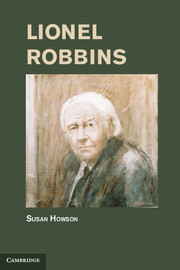Book contents
- Frontmatter
- Contents
- Illustrations
- Abbreviations
- Introduction
- One Father and Son
- Two The Great War
- Three Postwar
- Four The London School of Economics
- Five Iris Gardiner
- Six New College Oxford
- Seven The Young Professor
- Eight Fritz and Lionel
- Nine The School in the Mid-1930s
- Ten The Approach of War
- Eleven The Economics of War
- Twelve Director of the Economic Section
- Thirteen Anglo-American Conversations
- Fourteen The Law Mission and the Steering Committee
- Fifteen 1 9 4 4
- Sixteen The Last Months of the War
- Seventeen The Postwar Settlement
- Eighteen Return to the School
- Nineteen The End of the Transition
- Twenty LSE in the Early 1950s
- Twenty-One Chairman of the National Gallery
- Twenty-two Lord Robbins
- Twenty-three The Robbins Report
- Twenty-four The Sixties
- Twenty-five The Arts
- Twenty-six The Troubles at LSE
- Twenty-seven Retirement
- Conclusion
- Bibliography
- Index
Twenty-One - Chairman of the National Gallery
Published online by Cambridge University Press: 07 October 2011
- Frontmatter
- Contents
- Illustrations
- Abbreviations
- Introduction
- One Father and Son
- Two The Great War
- Three Postwar
- Four The London School of Economics
- Five Iris Gardiner
- Six New College Oxford
- Seven The Young Professor
- Eight Fritz and Lionel
- Nine The School in the Mid-1930s
- Ten The Approach of War
- Eleven The Economics of War
- Twelve Director of the Economic Section
- Thirteen Anglo-American Conversations
- Fourteen The Law Mission and the Steering Committee
- Fifteen 1 9 4 4
- Sixteen The Last Months of the War
- Seventeen The Postwar Settlement
- Eighteen Return to the School
- Nineteen The End of the Transition
- Twenty LSE in the Early 1950s
- Twenty-One Chairman of the National Gallery
- Twenty-two Lord Robbins
- Twenty-three The Robbins Report
- Twenty-four The Sixties
- Twenty-five The Arts
- Twenty-six The Troubles at LSE
- Twenty-seven Retirement
- Conclusion
- Bibliography
- Index
Summary
Lionel Robbins’s first seven-year term as a trustee of the National Gallery ended in July 1959. On relinquishing the chair he told his sister on 12 July that it was ‘in a way the end of an epoch for me – not the most important but perhaps the most rewarding & happiest office of my life.’ It had brought new friendships, notably with Philip Hendy and the sculptor Henry Moore. Hendy recalled (1968a, 658) that Robbins ‘had a rather unique relationship with the Civil Service and with governments throughout. It is due more to him than anyone else that the National Gallery Grant was enlarged. I don't think there’s anything better than a good board of trustees and a reasonably good director…working together. But this hasn't very often happened.’ This chapter discusses Robbins’s initiatives as chairman of the trustees of the National Gallery in 1954–9, and his service as a trustee of the Tate Gallery, before returning to his activities at LSE in the same period. In these years he continued to be asked to serve on government committees and was drawn once more into economic policymaking in 1957. The Torrens project came to fruition in 1956–8.
The ‘Tate Affair’, which cut short the Robbinses’ visit to the United States in 1954, began before Lionel joined the Tate board in October 1953. It had also started before Dennis Proctor, Lionel’s friend from Whitehall days, who had left the Treasury in 1950, succeeded Lord Jowitt as chairman of the Tate trustees in the summer of 1953. It was unfortunate Proctor had not become chairman earlier: Jowitt attempted a patched-up peace between the director John Rothenstein and LeRoux Smith LeRoux, one of the two deputy keepers and manager of the Publications Department, allowing continuation of his probationary appointment after his conduct had been severely criticized by a Treasury-commissioned report. Lionel later told Proctor that he had been warned by Eddie Playfair in the Treasury that ‘there was a man there [the Tate] – not named – who could be relied upon to create a major explosion within a few months’ (8 July 1968, Personal Correspondence 1966–70 M-R, RP). He came to believe (1971a, 263) that the man in question was ‘one of the most evil men I have ever encountered’. LeRoux, a South African, had been director of the Pretoria Art Centre when Rothenstein met him in 1948; after the election of the Nationalists Rothenstein’s recommendation had obtained LeRoux a temporary deputy keepership at the Tate; LeRoux represented himself ‘as a person of integrity who had fought apartheid and had lost his job because of his liberal stand’. But he was soon using his administrative skills, and his charm, to take over Rothenstein’s office and to spread rumours of Rothenstein’s incompetence – a claim he made to the trustees in October and November 1952 (when Proctor was abroad) leading to the Treasury’s enquiry into the ‘staff troubles’. Jowitt then offered LeRoux, Rothenstein’s ‘Iago’, a further probationary period of one year (Rothenstein 1966, 232–81; Spalding 1998, 105–11).
- Type
- Chapter
- Information
- Lionel Robbins , pp. 760 - 825Publisher: Cambridge University PressPrint publication year: 2011



